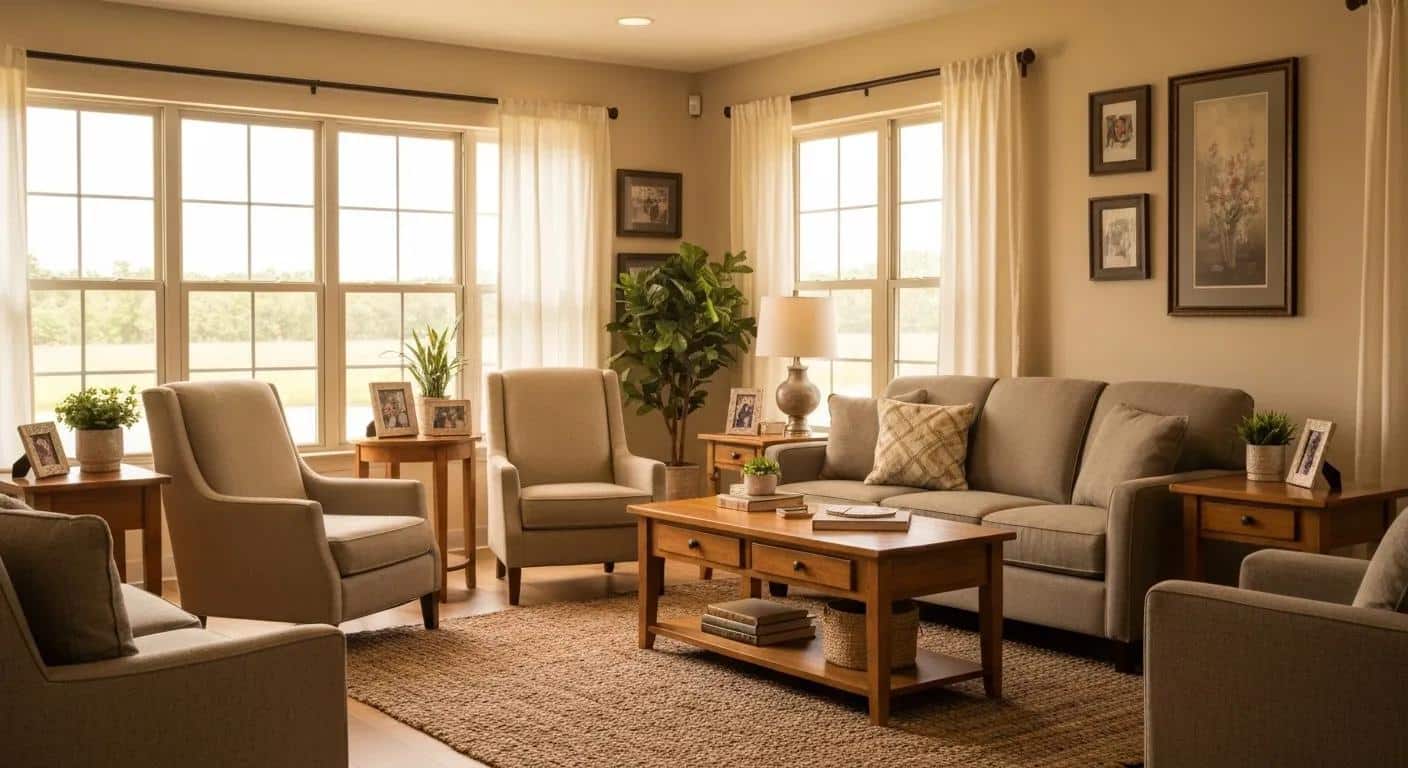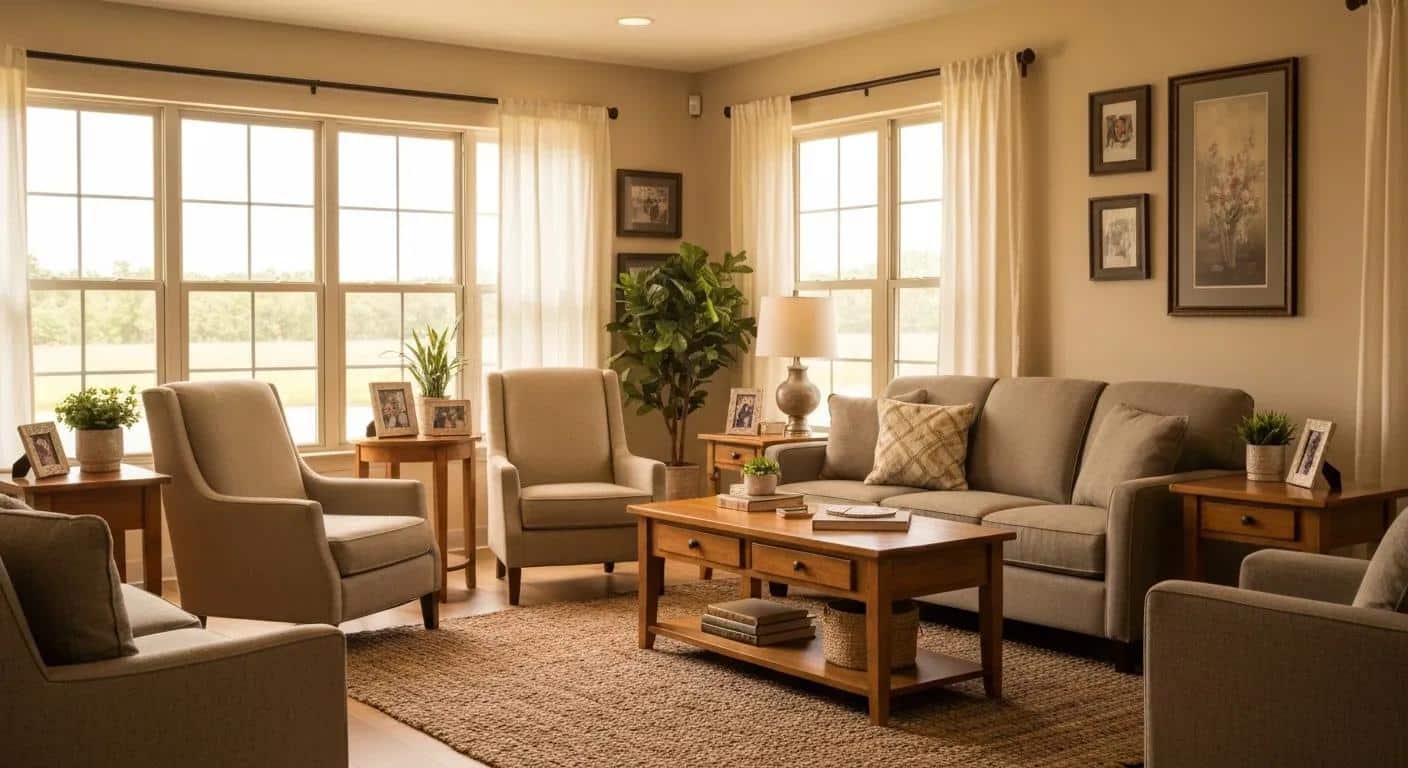Find the perfect assisted living Ypsilanti MI community in 5 simple steps. Explore needs, costs, tours, and make an informed decision today.

Discover Top Memory Care Facilities in Your Area Today
Discover Top Memory Care Facilities in Your Area Today

Find Local Memory Care Facilities for Dementia Support

Memory care facilities offer specialized environments designed to support seniors with mild to advanced dementia by combining secure living spaces with personalized care plans and engaging therapies. For families in Ypsilanti, Ann Arbor, and surrounding communities, locating the right memory care home involves understanding how a home-like setting, high caregiver-to-resident ratio, and targeted services promote residents’ safety, comfort, and cognitive engagement.
Memory Care and Dementia Support
Memory care facilities are designed to support seniors with dementia by providing secure environments, personalized care plans, and engaging therapies. These facilities focus on structured activities, environmental cues, and consistent caregiving to enhance safety and preserve quality of life for residents with cognitive decline.
This information supports the article’s introduction to memory care facilities and their purpose.
This guide will define memory care, explore the benefits of small residential homes, detail essential services and amenities, outline cost considerations and financial assistance, advise on timing for transitioning a loved one, explain how to identify top local facilities, and highlight why Memory Lane’s six-bedroom ranch houses stand out as a trusted choice.
What Are Memory Care Facilities and How Do They Support Seniors with Dementia?
Memory care facilities are residential settings that combine secure architecture, specially trained staff, and tailored daily routines to support seniors with dementia. By focusing on structured activities, environmental cues, and consistent caregiving, these communities enhance safety and preserve quality of life. For example, a resident experience at Memory Lane’s home-like ranch houses illustrates how familiar hallways and personalized engagement promote independence while reducing anxiety.
What is memory care and who needs it?
Memory care is specialized long-term support for adults experiencing cognitive decline due to Alzheimer’s disease or other forms of dementia, designed to maintain daily living abilities and emotional well-being. It integrates environmental modifications—such as secured exits, clear signage, and safe communal spaces—with compassionate caregivers trained in dementia protocols to reduce confusion and behavioral challenges. Individuals in early or mid-stage dementia who require increased supervision, assistance with activities of daily living, or cognitive stimulation benefit most from memory care services.
This definition leads naturally to understanding how memory care differs from standard assisted living models.
How does memory care differ from assisted living?
Below is a comparison of key attributes that distinguish specialized memory care from general assisted living.
These distinctions prepare families to evaluate different care models and narrow their search to dementia-focused residences.
What types of dementia are commonly supported in memory care?
Dementia Types and Care Considerations
Memory care homes typically support seniors with various cognitive conditions, adapting care plans to each diagnosis. Common dementia types include Alzheimer’s disease, vascular dementia, Lewy body dementia, and frontotemporal dementia, each requiring specific care considerations.
This citation provides context for the different types of dementia and how they are supported in memory care facilities, as discussed in the article.
The table below summarizes common dementia types and their primary care considerations.
Recognizing these variations informs personalized programming and therapeutic approaches in memory care.
What Are the Benefits of Choosing a Home-Like Memory Care Environment?

A home-like memory care setting enhances residents’ comfort and sense of familiarity, which can reduce agitation and improve daily interactions. By replicating residential floor plans, encouraging personalized décor, and maintaining consistent household routines, these environments support both emotional security and cognitive engagement.
How does a home-like setting improve quality of life for residents?
Below is a list of core ways that residential memory care environments enhance daily living for seniors with dementia:
- Personalized Ambiance and Décor align living spaces with residents’ preferences to spark positive memories.
- Consistent Routines and Mealtime Rituals stabilize daily rhythms, reducing confusion and stress.
- Small Household Groups foster social connections and allow staff to know each resident’s unique history and preferences.
These elements collectively support familiarity and emotional well-being, paving the way to explore the importance of caregiver ratios.
Why is a high caregiver-to-resident ratio important in memory care?

Maintaining a high caregiver-to-resident ratio ensures that staff can provide attentive, individualized support and swiftly respond to safety concerns. Consider these benefits:
- Enhanced Supervision prevents wandering and promotes secure freedom of movement.
- Rapid Response to behavioral changes or medical needs reduces risk of injury and distress.
- Tailored Engagement allows one-on-one cognitive stimulation and emotional reassurance.
Such attentive staffing strengthens trust and stability, which then leads to comparing smaller residential homes against larger institutions.
What makes small residential memory care homes different from large facilities?
Smaller memory care homes emphasize intimacy and consistency, often delivering a more personalized experience. The following list outlines distinctive advantages:
- Consistent Care Team minimizes staff turnover and promotes deep familiarity.
- Homelike Layouts eliminate hospital-like corridors, making orientation easier.
- Family-Style Dining encourages communal meals and natural social interaction.
These attributes guide families toward facilities that feel truly like home and foster stronger connections.
What Services and Amenities Are Offered in Memory Care Facilities?
Memory care facilities integrate a range of services and amenities to address cognitive, physical, and emotional needs. From tailored daily living assistance to specialized therapies, comprehensive service portfolios support residents’ well-being.
Which personalized care plans are available for seniors with dementia?
Memory care providers design individualized care plans that adapt as residents’ needs evolve. Typical plan components include:
- Activities of Daily Living (ADL) Assistance such as dressing, bathing, and grooming.
- Medication Management with scheduled reminders and professional oversight.
- Nutrition Support through customized meal planning to address dietary requirements.
These personalized plans ensure that every resident receives the right level of care at the right time, setting up the foundation for therapeutic programming.
What cognitive therapies and engaging activities support memory care residents?
Memory care homes offer non-pharmacological interventions to stimulate cognition and foster purpose. Examples of core therapies include:
- Reminiscence Therapy using personal photos or music to trigger positive memories.
- Structured Art and Music Sessions to engage multiple senses and encourage self-expression.
- Gentle Exercise Programs tailored to individual abilities to promote cardiovascular health and motor skills.
By integrating varied activities, facilities enhance mood, socialization, and cognitive resilience.
How do memory care facilities ensure safety and security?
Safety measures in memory care focus on preventing wandering and minimizing hazards. Common strategies include:
- Electronic Door Alarms and Wander Management Systems to alert staff of unsupervised exits.
- Secured Outdoor Courtyards that offer freedom to explore within a monitored space.
- Continuous Staff Rounds conducted throughout the day and night for early issue detection.
These protocols protect residents while supporting their freedom and dignity, enabling families to feel confident in the environment.
How Much Does Memory Care Cost and What Financial Assistance Is Available?
Memory care cost varies by region, facility size, and services provided. Understanding key cost drivers and available aid options helps families budget for long-term care.
What factors influence the cost of memory care in my area?
Below is a table of factors that most directly affect memory care pricing in communities like Ypsilanti and Ann Arbor.
Families can use these insights to compare quotes and negotiate services that align with care priorities.
What financial aid options help cover memory care expenses?
Several funding sources help offset memory care costs for eligible seniors:
- Medicaid Waivers for home-and community-based services in certain states.
- Long-Term Care Insurance policies that reimburse qualified care expenses.
- Veterans Affairs (VA) Benefits offering Aid & Attendance allowances to veterans and surviving spouses.
Combining these avenues with personal savings can make memory care more affordable and accessible.
How does memory care cost compare to assisted living?
Memory care typically costs 15–30% more than assisted living because of enhanced staffing, security, and specialized therapies. Key cost differentials include:
- Staff Expertise Premium: Dementia-trained caregivers command higher salaries.
- Security Infrastructure: Advanced monitoring and secured layouts increase facility investment.
- Therapeutic Programming: Non-pharmacological interventions demand dedicated staff and materials.
Understanding these distinctions helps families weigh value against budget constraints.
When Is It Time to Move a Loved One to a Memory Care Facility?
Timing the transition to memory care requires balancing safety concerns with emotional readiness. Recognizing early signs and preparing thoughtfully can ease the change.
What are the early signs that indicate the need for memory care?
- Frequent Wandering or getting lost in familiar places.
- Increased Confusion about time, place, or people.
- Difficulty with Basic Self-Care tasks such as dressing or toileting.
Noticing these indicators early can prompt timely planning and improve outcomes.
How can families prepare for the transition to memory care?
- Tour multiple facilities to compare environments and services.
- Involve the loved one in room-decor decisions to foster ownership.
- Establish a familiar routine before move-in day to reduce anxiety.
Preparation supports emotional acceptance and continuity of care.
What family support resources are available during this process?
- Dementia Education Workshops that explain disease progression and communication strategies.
- Caregiver Support Groups where relatives share experiences and coping techniques.
- Family Counseling Services to address emotional challenges and planning concerns.
Engaging these resources ensures that families remain informed and resilient as they navigate care journeys.
How Can I Find the Best Memory Care Facilities in My Area?
Identifying top memory care homes involves evaluating key criteria, understanding local options, and matching them to your loved one’s needs.
What should I look for when choosing a memory care facility?
When touring memory care residences, prioritize these essential factors:
- Staff Training Programs that emphasize dementia certification and ongoing education.
- Resident Engagement Activities demonstrating personalized cognitive interventions.
- Secure, Homelike Environment offering both safety and comfort.
- Transparent Cost Structure with clear breakdowns of service fees.
Considering these elements helps families select a facility aligned with quality and values.
How does Memory Lane’s approach stand out in local memory care options?
Memory Lane’s six-bedroom ranch houses combine residential scale with specialized dementia care, ensuring each resident benefits from a high staff-to-resident ratio and a snug, familiar layout. Caregivers receive advanced dementia training that promotes individualized attention, and each home emphasizes personal décor and daily routines tailored to residents’ life stories. This unique model enhances comfort, reduces agitation, and supports family involvement.
Where are memory care facilities located near me?
- Ypsilanti, MI – Intimate ranch house settings near local parks.
- Ann Arbor, MI – Accessible neighborhood homes with community partnerships.
- Saline, MI – Tranquil suburban environment with secure outdoor spaces.
These locations provide convenient options for in-region memory care support.
Why Choose Memory Lane for Your Loved One’s Memory Care Needs?
Memory Lane offers a specialized home-like model, personalized care plans, and a trusted reputation that families rely on when making critical dementia care decisions.
What unique value does Memory Lane offer in memory care?
- Six-bedroom residences designed to feel and function as personal homes.
- A consistently low staff ratio—often one caregiver per three residents during peak hours.
- Proprietary engagement programs that weave personal histories into daily activities.
These unique features promote safety, connection, and cognitive stability.
What do families say about their experience with Memory Lane?
Family testimonials highlight enhanced peace of mind and noticeable improvements in their loved ones’ well-being. One daughter reports meaningful increases in her mother’s social participation after moving into a Memory Lane home, while another spouse notes reduced anxiety and clearer communication during visits. Such feedback underscores the trust families place in Memory Lane’s approach.
How does Memory Lane support ongoing family involvement and communication?
- Weekly care conferences that review progress and adjust care plans.
- Personalized digital photo and activity logs shared with relatives.
- Scheduled family events and workshops that foster community connections.
This commitment to open dialogue and inclusion ensures families remain central to their loved one’s care journey.
Residents thrive when care settings balance safety, engagement, and a genuine sense of home. Memory care facilities that deliver personalized programming, robust safety measures, and a high caregiver-to-resident ratio provide seniors with dementia the best chance to live comfortably and meaningfully. By evaluating facility models, services, costs, transition timing, and distinctive values like those offered by Memory Lane, families can confidently choose a memory care home that honors their loved one’s history and supports their evolving needs. Trust in a compassionate environment to nurture security, independence, and connection in every stage of dementia care.
Frequently Asked Questions
What should families consider when visiting memory care facilities?
When visiting memory care facilities, families should prioritize several key factors. Look for staff training programs that emphasize dementia-specific education and ongoing training. Observe the types of resident engagement activities offered, as these can indicate the level of personalized care. Additionally, assess the environment to ensure it feels secure and homelike, which is crucial for residents’ comfort. Lastly, inquire about the facility’s cost structure to understand all potential fees and services included, ensuring transparency in financial matters.
How can I assess the quality of care in a memory care facility?
To assess the quality of care in a memory care facility, consider observing staff interactions with residents. High-quality care is often reflected in the attentiveness and compassion of caregivers. Additionally, check for consistent caregiver-to-resident ratios, as this impacts the level of individualized attention each resident receives. Look for structured activities that promote cognitive engagement and emotional well-being. Lastly, seek feedback from current residents’ families to gain insights into their experiences and satisfaction with the care provided.
What role do family members play in the care of their loved ones in memory care?
Family members play a crucial role in the care of their loved ones in memory care facilities. They can provide valuable insights into the resident’s history, preferences, and needs, which can help caregivers tailor care plans effectively. Regular communication with staff during care conferences allows families to stay informed about their loved one’s progress and any changes in care. Additionally, family involvement in activities and events fosters a sense of community and connection, enhancing the overall well-being of residents.
What are the common challenges families face when transitioning a loved one to memory care?
Transitioning a loved one to memory care can present several challenges for families. Emotional resistance from the individual, stemming from feelings of loss or confusion, is common and can complicate the move. Families may also struggle with feelings of guilt or uncertainty about the decision. Additionally, logistical challenges, such as finding the right facility and managing the costs, can add stress. Preparing for these challenges through education, open communication, and support resources can help ease the transition process for everyone involved.
How can I ensure my loved one feels comfortable in their new memory care environment?
To ensure your loved one feels comfortable in their new memory care environment, involve them in the transition process as much as possible. Allow them to personalize their living space with familiar items, such as photos or favorite decorations, to create a sense of home. Establish a consistent routine that mirrors their previous daily activities to reduce anxiety. Regular visits and communication can also help them feel connected and supported during this adjustment period, fostering a smoother transition into their new surroundings.
What types of activities are beneficial for residents in memory care facilities?
Beneficial activities for residents in memory care facilities include cognitive stimulation exercises, such as puzzles and memory games, which can help maintain mental acuity. Engaging in arts and crafts allows for creative expression and can evoke positive memories. Music therapy is also effective, as it can enhance mood and encourage social interaction. Additionally, gentle physical activities, like walking or chair exercises, promote physical health and mobility. Tailoring activities to individual preferences ensures that residents remain engaged and fulfilled in their daily lives.
Conclusion
Choosing a memory care facility that prioritizes personalized care, safety, and a home-like environment can significantly enhance the quality of life for seniors with dementia. By understanding the unique benefits of smaller residential homes and the importance of caregiver ratios, families can make informed decisions that align with their loved ones’ needs. Take the next step in securing compassionate support by exploring local memory care options tailored to your family’s requirements. Trust in a nurturing environment to foster connection and comfort for your loved one during their journey.


